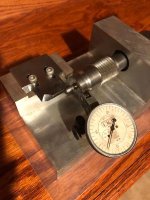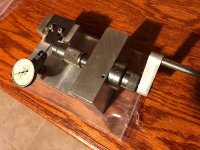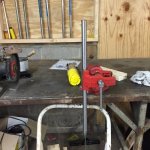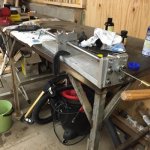tonykharper
Well-known member
In another thread we got off topic and started discussing chambers for RFBR rifles.
People often say they have a chamber for Eley or a chamber for Lapua. I asked the question what is it that makes a chamber unique to one brand of ammo?
I've chambered a number of barrels, but I do not claim to know the best way to do it. What you read here is just me. No claim to be right.
It may very well be the worst way to chamber a barrel. If you choose to use any of this, do it at your own risk.
Many people choose to bore their chambers, some even bore part way, and finish the leade with a reamer.
I've tried it, but didn't like it. Perhaps you need better equipment than I have. I have an old South Bend Heavy 10 Lathe.
This is a pic of my shop and Lathe. This is old equipment, but it still works. The ARA indoor Nationals was just won by a rifle built 13 years ago on equipment much older than this.
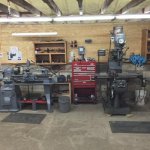
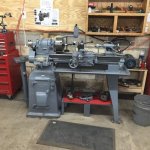
Here is a list of popular .22 rimfire reamers. I've only used four of them. The reamer I use now is a spiral cut cobalt Calfee reamer. It is straight sided and has a 2-degree leade.
I think Bill Meyers used a 1.30 degree leade reamer. There may be people that can tell a 1.30 from a 2.0 but I'm not one of them. Does it make a difference? I doubt it.
Who knows what happens to the angle of the leade when you finish the chamber? I bet it changes.
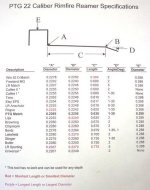
These are reamers I have used.


Now you know the equipment I'm working with you may be able to help me.
I have chambered some really good barrels. Some have even set world records. But only rarely are any of my chambers alike.
I chamber using my best ammo as my guide. I know I want the bullet engraved to the second driving band but not further.
The problem is the second driving band isn't in the same place on every round. Certainly not brand to brand, or lot to lot.
I end up using 20-30 rounds of my best ammo to get an average. I then cut to that number. It is always a compromise.
Before you even ask, when that lot number runs out, I try to find another that was like the last but not always possible.
If anyone out there has magic numbers, please share.
TKH (4628)
People often say they have a chamber for Eley or a chamber for Lapua. I asked the question what is it that makes a chamber unique to one brand of ammo?
I've chambered a number of barrels, but I do not claim to know the best way to do it. What you read here is just me. No claim to be right.
It may very well be the worst way to chamber a barrel. If you choose to use any of this, do it at your own risk.
Many people choose to bore their chambers, some even bore part way, and finish the leade with a reamer.
I've tried it, but didn't like it. Perhaps you need better equipment than I have. I have an old South Bend Heavy 10 Lathe.
This is a pic of my shop and Lathe. This is old equipment, but it still works. The ARA indoor Nationals was just won by a rifle built 13 years ago on equipment much older than this.


Here is a list of popular .22 rimfire reamers. I've only used four of them. The reamer I use now is a spiral cut cobalt Calfee reamer. It is straight sided and has a 2-degree leade.
I think Bill Meyers used a 1.30 degree leade reamer. There may be people that can tell a 1.30 from a 2.0 but I'm not one of them. Does it make a difference? I doubt it.
Who knows what happens to the angle of the leade when you finish the chamber? I bet it changes.

These are reamers I have used.


Now you know the equipment I'm working with you may be able to help me.
I have chambered some really good barrels. Some have even set world records. But only rarely are any of my chambers alike.
I chamber using my best ammo as my guide. I know I want the bullet engraved to the second driving band but not further.
The problem is the second driving band isn't in the same place on every round. Certainly not brand to brand, or lot to lot.
I end up using 20-30 rounds of my best ammo to get an average. I then cut to that number. It is always a compromise.
Before you even ask, when that lot number runs out, I try to find another that was like the last but not always possible.
If anyone out there has magic numbers, please share.
TKH (4628)
Last edited:


